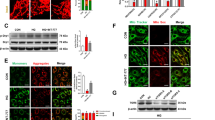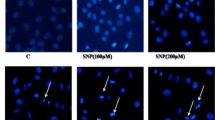Abstract
Objective
Pleckstrin homology domain and leucine-rich repeat protein phosphatase 2 (PHLPP2) is linked to various pathological states. However, whether PHLPP2 mediates diabetic retinopathy is unaddressed. This work explored the biological function of PHLPP2 in modulating high glucose (HG)-elicited damage of retinal ganglion cells (RGCs), an in vitro model for studying diabetic retinopathy.
Methods
Mouse RGCs were treated with HG to establish a cell model. PHLPP2 was silenced by transfecting specific shRNAs targeting PHLPP2. RT-qPCR, immunoblotting, CCK-8 assay, flow cytometry, TUNEL assay, and ELISA were carried out.
Results
Significant increases in PHLPP2 levels were observed in cultured RGCs exposed to HG. The severe damages evoked by HG to RGCs were remarkably weakened in PHLPP2-silenced RGCs, including improved cell survival, attenuated cell apoptosis, repressed oxidative stress, and prohibited proinflammatory response. The silencing of PHLPP2 strengthened the activation of Nrf2 in HG-treated RGCs via modulation of the Akt–GSK–3β axis. Interruption of the Akt–GSK–3β axis reversed PHLPP2-silencing-elicited Nrf2 activation. The protective effects of PHLPP2 silencing on HG-induced injury of RGCs were diminished by Nrf2 inhibition.
Conclusions
The loss of PHLPP2 was beneficial for HG-injured RGCs through the effect on the Akt–GSK–3β–Nrf2 pathway. This work suggests a possible role of PHLPP2 in diabetic retinopathy.









Similar content being viewed by others
Data availability
The datasets used during the present study are available from the corresponding author on reasonable request.
Abbreviations
- PHLPP2:
-
Pleckstrin homology domain and leucine-rich repeat protein phosphatase 2
- HG:
-
High glucose
- RGCs:
-
Retinal ganglion cells
- Nrf2:
-
Nuclear factor erythroid 2-related factor 2
- GSK-3β:
-
Glycogen synthase kinase-3β
- ARE:
-
Anti-oxidant response elements
- RT-qPCR:
-
Real-time quantitative polymerase chain reaction
- MDA:
-
Malondialdehyde
- SOD:
-
Superoxide dismutase
- ELISA:
-
Enzyme-linked immunosorbent
- IL:
-
Interleukin
- TNF:
-
Tumor necrosis factor
References
Wong TY, Cheung CM, Larsen M, Sharma S, Simo R. Diabetic retinopathy. Nat Rev Dis Primers. 2016;2:16012.
Simo R, Hernandez C, European Consortium for the Early Treatment of Diabetic R. Neurodegeneration in the diabetic eye: new insights and therapeutic perspectives. Trends Endocrinol Metab. 2014;25:23–33.
Baden T, Berens P, Franke K, Roman Roson M, Bethge M, Euler T. The functional diversity of retinal ganglion cells in the mouse. Nature. 2016;529:345–50.
Jadeja RN, Martin PM. Oxidative stress and inflammation in retinal degeneration. Antioxidants (Basel). 2021;10:790.
Chalke SD, Kale PP. Combination approaches targeting neurodegeneration, oxidative stress and inflammation in the treatment of diabetic retinopathy. Curr Drug Targets. 2021;22:1810–24.
Gao T, Furnari F, Newton AC. PHLPP: a phosphatase that directly dephosphorylates Akt, promotes apoptosis, and suppresses tumor growth. Mol Cell. 2005;18:13–24.
O’Neill AK, Niederst MJ, Newton AC. Suppression of survival signalling pathways by the phosphatase PHLPP. FEBS J. 2013;280:572–83.
Brognard J, Newton AC. PHLiPPing the switch on Akt and protein kinase C signaling. Trends Endocrinol Metab. 2008;19:223–30.
Warfel NA, Newton AC. Pleckstrin homology domain leucine-rich repeat protein phosphatase (PHLPP): a new player in cell signaling. J Biol Chem. 2012;287:3610–6.
Mathur A, Pandey VK, Kakkar P. PHLPP: a putative cellular target during insulin resistance and type 2 diabetes. J Endocrinol. 2017;233:R185–98.
Kim K, Kang JK, Jung YH, Lee SB, Rametta R, Dongiovanni P, et al. Adipocyte PHLPP2 inhibition prevents obesity-induced fatty liver. Nat Commun. 2021;12:1822.
Yeh ST, Zambrano CM, Koch WJ, Purcell NH. PH domain leucine-rich repeat protein phosphatase 2 (PHLPP2) regulates G-protein-coupled receptor kinase 5 (GRK5)-induced cardiac hypertrophy in vitro. J Biol Chem. 2018;293:8056–64.
Liu J, Weiss HL, Rychahou P, Jackson LN, Evers BM, Gao T. Loss of PHLPP expression in colon cancer: role in proliferation and tumorigenesis. Oncogene. 2009;28:994–1004.
Huang H, Pan X, Jin H, Li Y, Zhang L, Yang C, et al. PHLPP2 Downregulation contributes to lung carcinogenesis following B[a]P/B[a]PDE exposure. Clin Cancer Res. 2015;21:3783–93.
Lemoine KA, Fassas JM, Ohannesian SH, Purcell NH. On the PHLPPside: emerging roles of PHLPP phosphatases in the heart. Cell Signal. 2021;86: 110097.
Brognard J, Sierecki E, Gao T, Newton AC. PHLPP and a second isoform, PHLPP2, differentially attenuate the amplitude of Akt signaling by regulating distinct Akt isoforms. Mol Cell. 2007;25:917–31.
Wei XE, Zhang FY, Wang K, Zhang QX, Rong LQ. Assembly of the FKBP51-PHLPP2-AKT signaling complex in cerebral ischemia/reperfusion injury in rats. Brain Res. 2014;1566:60–8.
Jin A, Li B, Li W, Xiao D. PHLPP2 downregulation protects cardiomyocytes against hypoxia-induced injury through reinforcing Nrf2/ARE antioxidant signaling. Chem Biol Interact. 2019;314: 108848.
Wen YA, Li X, Goretsky T, Weiss HL, Barrett TA, Gao T. Loss of PHLPP protects against colitis by inhibiting intestinal epithelial cell apoptosis. Biochim Biophys Acta. 2015;1852:2013–23.
Rizvi F, Mathur A, Kakkar P. Morin mitigates acetaminophen-induced liver injury by potentiating Nrf2 regulated survival mechanism through molecular intervention in PHLPP2-Akt-Gsk3beta axis. Apoptosis. 2015;20:1296–306.
Mathur A, Rizvi F, Kakkar P. PHLPP2 down regulation influences nuclear Nrf2 stability via Akt-1/Gsk3beta/Fyn kinase axis in acetaminophen induced oxidative renal toxicity: protection accorded by morin. Food Chem Toxicol. 2016;89:19–31.
Gan L, Johnson JA. Oxidative damage and the Nrf2-ARE pathway in neurodegenerative diseases. Biochim Biophys Acta. 2014;1842:1208–18.
Motohashi H, Katsuoka F, Engel JD, Yamamoto M. Small Maf proteins serve as transcriptional cofactors for keratinocyte differentiation in the Keap1-Nrf2 regulatory pathway. Proc Natl Acad Sci U S A. 2004;101:6379–84.
Chen QM. Nrf2 for cardiac protection: pharmacological options against oxidative stress. Trends Pharmacol Sci. 2021;42:729–44.
Jimenez-Villegas J, Ferraiuolo L, Mead RJ, Shaw PJ, Cuadrado A, Rojo AI. NRF2 as a therapeutic opportunity to impact in the molecular roadmap of ALS. Free Radic Biol Med. 2021;173:125–41.
Stenvinkel P, Chertow GM, Devarajan P, Levin A, Andreoli SP, Bangalore S, et al. Chronic inflammation in chronic kidney disease progression: role of Nrf2. Kidney Int Rep. 2021;6:1775–87.
Kowluru RA, Mishra M. Epigenetic regulation of redox signaling in diabetic retinopathy: role of Nrf2. Free Radic Biol Med. 2017;103:155–64.
Nabavi SF, Barber AJ, Spagnuolo C, Russo GL, Daglia M, Nabavi SM, et al. Nrf2 as molecular target for polyphenols: a novel therapeutic strategy in diabetic retinopathy. Crit Rev Clin Lab Sci. 2016;53:293–312.
Li CP, Wang SH, Wang WQ, Song SG, Liu XM. Long noncoding RNA-Sox2OT knockdown alleviates diabetes mellitus-induced retinal ganglion cell (RGC) injury. Cell Mol Neurobiol. 2017;37:361–9.
Lv P, Yu J, Xu X, Lu T, Xu F. Eriodictyol inhibits high glucose-induced oxidative stress and inflammation in retinal ganglial cells. J Cell Biochem. 2019;120:5644–51.
Sun W, Yu J, Kang Q. Upregulation of heme oxygenase-1 by Brahma-related gene 1 through Nrf2 signaling confers protective effect against high glucose-induced oxidative damage of retinal ganglion cells. Eur J Pharmacol. 2020;875: 173038.
Fao L, Mota SI, Rego AC. Shaping the Nrf2-ARE-related pathways in Alzheimer’s and Parkinson’s diseases. Ageing Res Rev. 2019;54: 100942.
Hayes JD, Chowdhry S, Dinkova-Kostova AT, Sutherland C. Dual regulation of transcription factor Nrf2 by Keap1 and by the combined actions of beta-TrCP and GSK-3. Biochem Soc Trans. 2015;43:611–20.
Chowdhry S, Zhang Y, McMahon M, Sutherland C, Cuadrado A, Hayes JD. Nrf2 is controlled by two distinct beta-TrCP recognition motifs in its Neh6 domain, one of which can be modulated by GSK-3 activity. Oncogene. 2013;32:3765–81.
Zhou Z, Li H, Bai S, Xu Z, Jiao Y. Loss of serine/threonine protein kinase 25 in retinal ganglion cells ameliorates high glucose-elicited damage through regulation of the AKT-GSK-3beta/Nrf2 pathway. Biochem Biophys Res Commun. 2022;600:87–93.
Rizvi F, Mathur A, Krishna S, Siddiqi MI, Kakkar P. Suppression in PHLPP2 induction by morin promotes Nrf2-regulated cellular defenses against oxidative injury to primary rat hepatocytes. Redox Biol. 2015;6:587–98.
Xing H, Fu R, Cheng C, Cai Y, Wang X, Deng D, et al. Hyperoside protected against oxidative stress-induced liver injury via the PHLPP2-AKT-GSK-3beta signaling pathway in vivo and in vitro. Front Pharmacol. 2020;11:1065.
Yan X, Li W, Yang L, Dong W, Chen W, Mao Y, et al. MiR-135a protects vascular endothelial cells against ventilator-induced lung injury by inhibiting PHLPP2 to activate PI3K/Akt pathway. Cell Physiol Biochem. 2018;48:1245–58.
Sun X, Lin J, Zhang Y, Kang S, Belkin N, Wara AK, et al. MicroRNA-181b improves glucose homeostasis and insulin sensitivity by regulating endothelial function in white adipose tissue. Circ Res. 2016;118:810–21.
Rizvi F, Shukla S, Kakkar P. Essential role of PH domain and leucine-rich repeat protein phosphatase 2 in Nrf2 suppression via modulation of Akt/GSK3beta/Fyn kinase axis during oxidative hepatocellular toxicity. Cell Death Dis. 2014;5: e1153.
Funding
This work was supported by the Natural Science Basic Research Program of Shaanxi, China (No. 2020JM-400) and the Key Research & Development Program of Shaanxi Province (No. 2020SF-268).
Author information
Authors and Affiliations
Contributions
XL and YL contributed to conceptualization and design. XL wrote the manuscript. YL reviewed the manuscript. XL and LC performed the experiments. ZZ, LC, and TW performed data analysis and provided technical support.
Corresponding authors
Ethics declarations
Conflict of interest
The authors have no competing interests to declare that are relevant to the content of this article.
Additional information
Responsible Editor: John Di Battista.
Publisher's Note
Springer Nature remains neutral with regard to jurisdictional claims in published maps and institutional affiliations.
Rights and permissions
Springer Nature or its licensor (e.g. a society or other partner) holds exclusive rights to this article under a publishing agreement with the author(s) or other rightsholder(s); author self-archiving of the accepted manuscript version of this article is solely governed by the terms of such publishing agreement and applicable law.
About this article
Cite this article
Liu, X., Liu, Y., Chen, L. et al. Loss of pleckstrin homology domain and leucine-rich repeat protein phosphatase 2 has protective effects on high glucose-injured retinal ganglion cells via the effect on the Akt–GSK–3β–Nrf2 pathway. Inflamm. Res. 72, 373–385 (2023). https://doi.org/10.1007/s00011-022-01680-1
Received:
Revised:
Accepted:
Published:
Issue Date:
DOI: https://doi.org/10.1007/s00011-022-01680-1




